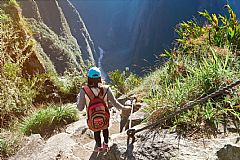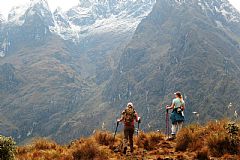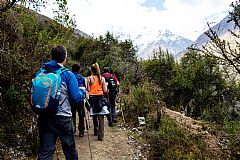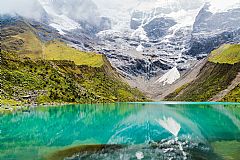Prepare your hiking boots, walking sticks and pack, because today we bring you four hiking recommendations that you cannot miss if you travel to the ancient capital of the Incan Empire.
If ten years ago travelers arrived at Cusco to only visit Machu Picchu and the Sacred Valley, today the panorama is totally different and hiking has converted in one of the unmissable activities to discover surrounding the city.
Enormous snowy mountains, turquoise lagoons, cloud forests, archeological ruins and ancient trails are part of the trekking routes that you can do from Cusco. So, if you have a trip to the ancient capital of the Incan empire in mind, at Let’s Visit Perú we recommend some of the most outstanding places and activities.
1. The Inca Trail
Without a doubt this is the most famous trekking route in all of Peru. In total, 43 kilometers separate the village Piscacucho from Machu Picchu is the most traveled route of the Qhapaq Ñan, the network of trails that the Inca Pachacutec built to connect the different cities that formed part of his empire.
The trajectory takes four days and passes through cloud forests, ancient staircases and archaeological remains, and reaches up to 4.200 msnm. At the end the Sun Door, or la Puerta del Sol, marks the entrance to the Sacred Citadel of Machu Picchu, where this trail ends. It is not extremely difficult but does require a few weeks of preparation to maintain the pace and to be in good physical shape.
The best part of the year to visit the Inca Trail is March to May and September to November to avoid the high season and the altiplanic winter. In addition, it is obligatory to do the trek through an authorized tour operator, who are the only ones that can obtain the entrance authorization.
2. Vinicunca
Also known as the Mountain of Seven Colors or Rainbow Mountain, Vinicunca is one the most beautiful landscapes in all of Peru. This peak is located in the Vilcanota mountain range and its indescribable beauty is due to its yellow, purple, green and blue tones of its earth.
The hike begins at the village Punta, located at 4.500 msnm, where it is recommended to stop a few times on the way to adjust to the altitude. From there the hike lasts three and a half hours on a trail of medium-high difficulty until arriving at its peak (5.029 msnm).
The same as the Inca trail, the best time of year to visit the Rainbow Mountain is between March and May and September to November to avoid the rainy season and the large number of tourists that arrive during winter.
3. Salkantay
An alternative to the Inca Trail, this route was also constructed by the incas to connect their commerce. It is recommended to do it in four days to have sufficient time and go slowly because the highest point reaches an altitude of 4.600 msnm.
The route begins in Challancancha, and for a day and a half it will be all uphill until Abra Salkantay. However, you will find yourself in impressive scenery such as the Humantay lagoon, the snowy mountains and the beautiful coffee plantations, where you will see that all of the effort is worth it. The hike ends in the town Aguas Calientes from where you can take a tour of the Sacred Citadel of Machu Picchu.
The best time of year to do this trek to Salkantay is in the dry season, from May to October, avoiding the winter months because many tourists arrive in the area. In addition, your backpack must not surpass more than 5 kilograms, the maximum that the mules can carry during your trajectory.
4. Choquequirao
Since 1970, investigators have been working to uncover the citadel of Choquequirao, after it was discovered in 1909 by the American archaeologist Hiram Bingham. Today, it is estimated that only 30% of the total ruins that form part of this Incan cultural and religious center have been uncovered.
This complex archaeological site is located relatively close to Machu Picchu, but it is not easy to get to. The trek to arrive takes around three days and begins in the town Cachora, later arriving to cross the Apurimac canyon, the deepest canyon on the continent.
Although it may not be very long, the Choquequirao trek is of high difficulty because it is comprised of many climbs and descents in small trajectories. However, once you arrive you will realize that the effort was worth it. You won’t encounter more than 30 people even if you go during the high season.
Do you want to do one of the trekking routes? Review and reserve our programs online or contact us at sales@letsvisitperu.com to create a trip catered to your needs!










